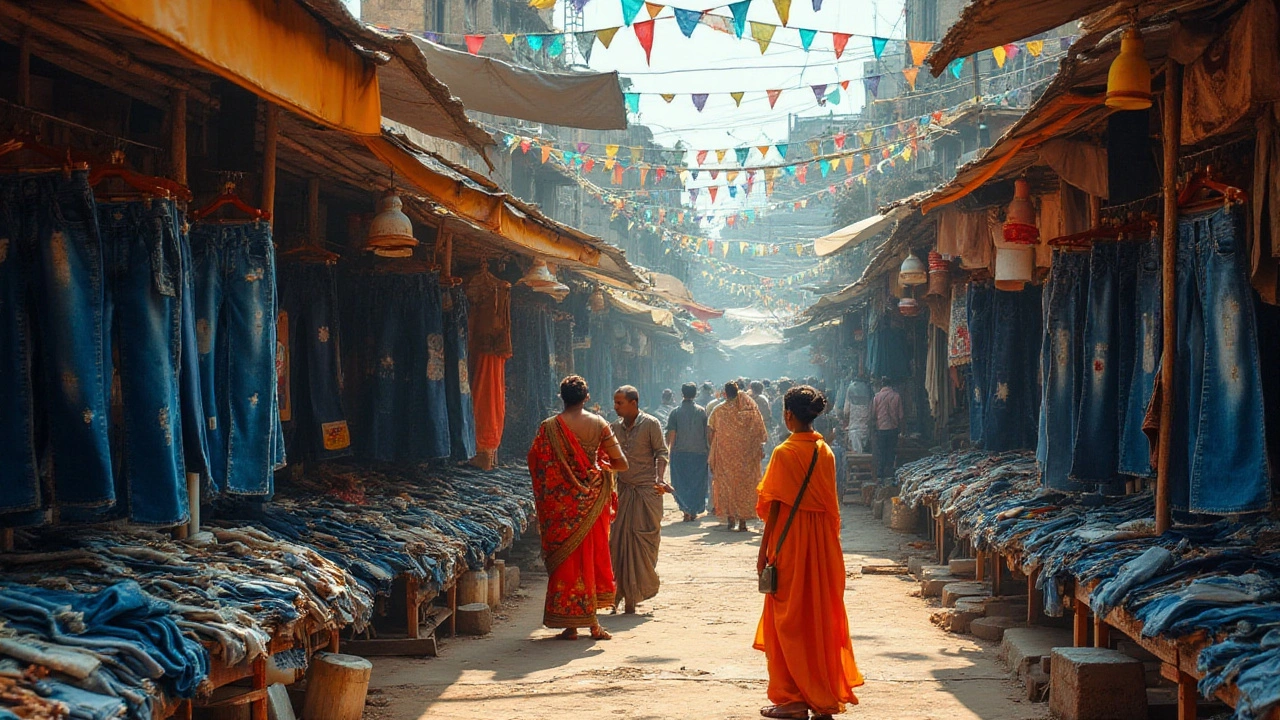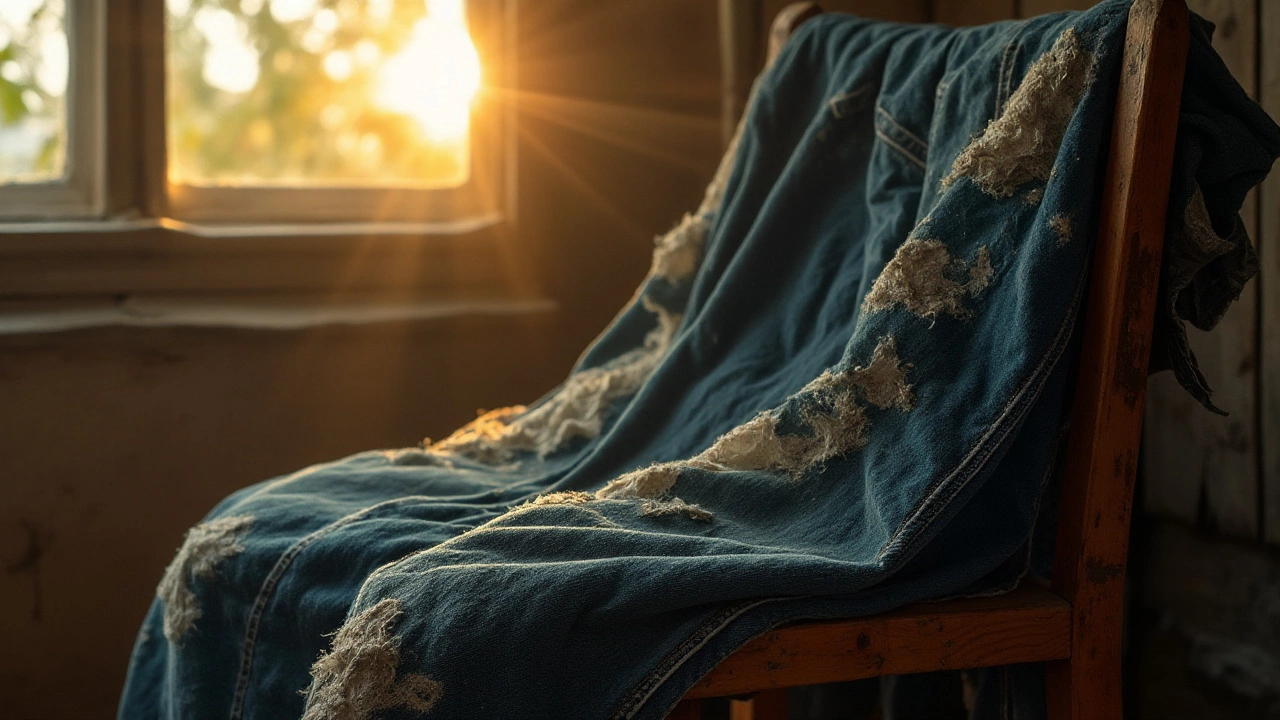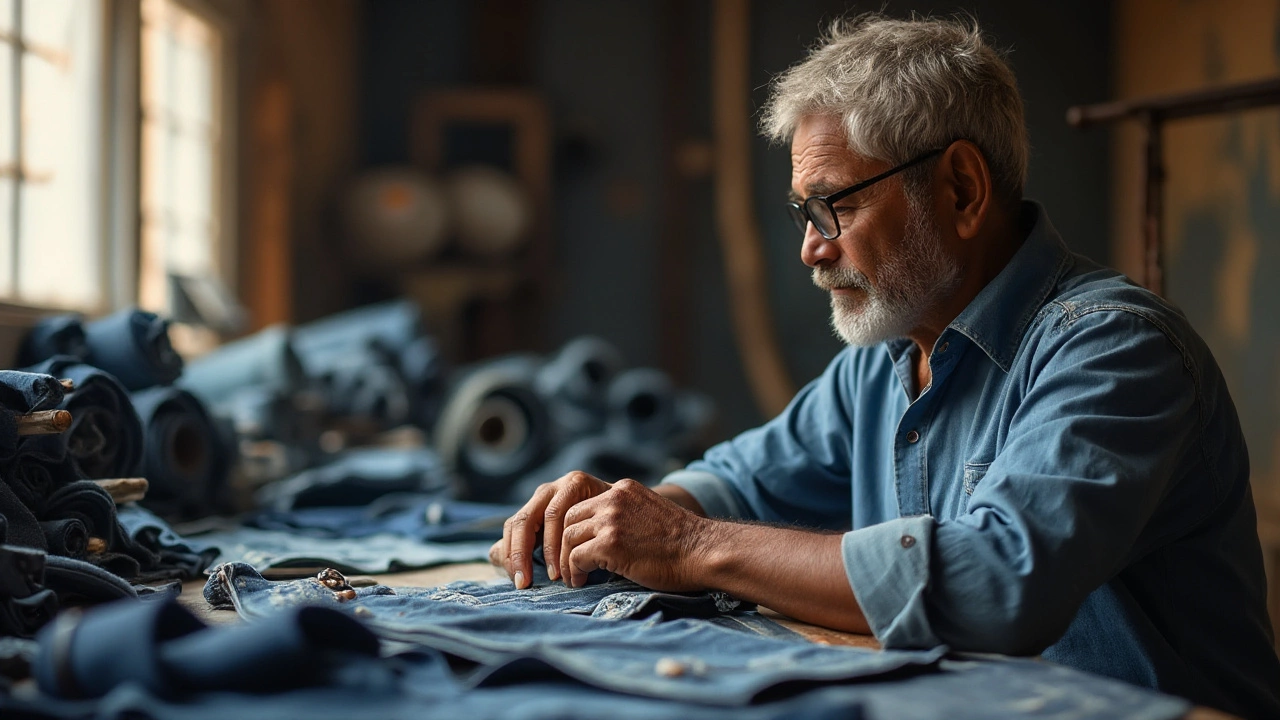There's something undeniably special about slipping into a pair of old jeans. The soft yet sturdy embrace of fabric that has witnessed the passage of time feels nothing short of magical. Beyond the nostalgia, old jeans boast a quality and charm that modern pairs often seem to lack.
This isn't just a tale woven from the threads of memory. It's grounded in reality, where yesterday's craftsmanship meets durable materials to create pieces that are unparalleled today. This journey into the world of denim reveals why older jeans aren't just a fleeting trend but a timeless fashion statement.
We'll delve into the reasons vintage denim continues to captivate wardrobes worldwide, ranging from its unique wear patterns to its environmental benefits. Whether you're a seasoned hunter of thrift store gems or simply curious about these iconic pieces, this exploration is sure to offer fresh insights into why the past often fits better than the present.
- The Craftsmanship of Yesteryear
- Material Matters: The Fabric of Vintage Denim
- A Character Like No Other
- Environmental and Social Benefits
- Tips for Finding Quality Old Jeans
- Caring for Your Vintage Finds
The Craftsmanship of Yesteryear
When it comes to old jeans, it's easy to imagine skilled artisans working diligently over sturdy machines, crafting garments with care that went beyond mere minutes on an assembly line. Back in the day, creating a pair of jeans wasn't just about efficiency; it was about pride and dedication to making clothing that lasted. The denim quality was more than a byproduct of the materials used—though cotton was of a higher standard—it also depended significantly on the hands that stitched them. Craftsmen employed time-honored techniques, ensuring every seam was robust, and every fit was comfortable yet durable. It was a time when hand-stitched details weren't merely aesthetic but added structural integrity to the jeans.
To understand this, consider the role of traditional shuttle looms, a weaving method that produced denim with a distinctive selvage edge. This process, now largely overtaken by modern technology, required more time and expertise but resulted in a fabric renowned for its strength and reduced fraying. The attention to detail did not end at weave but extended to how jeans were dyed. Natural indigo dyeing was a meticulous art that produced deep, rich hues that gracefully aged over time, adding character to each piece. These elements combined to form clothing that was not only practical but with style that echoed endurance. Even Levi's, a brand synonymous with vintage jeans, advocates the durability of their original designs, noting how they 'personified the era's spirit of rugged individuality.'
"Craftsmanship is about making fine details appear effortless," says John Smith, a renowned denim historian. "Old jeans tell their own story, a narrative stitched into each thread through the sheer skill and intention of their creators."
Another layer to consider is the personalized fit that yesteryear jeans offered. Unlike today’s mass-produced options, those jeans were often designed to mold to the wearer's body with time, ensuring each pair was almost bespoke. This quality made denim fashion a personal statement. By responding to the wearer's movements, the fabric developed unique fading patterns akin to fingerprints, distinguishing each pair. Thus, older jeans presented a level of personalization hard to find in today's fast-fashion cultures. As environmental and social benefits become increasingly significant, revisiting these practices from the past not only brings nostalgia but valuable lessons on sustainability and craftsmanship.
Material Matters: The Fabric of Vintage Denim
The fabric of vintage denim holds secrets that modern clothes try hard to replicate but rarely capture. Back in the day, the process of crafting jeans was rooted in principles of durability and quality. The main component, the denim itself, was often crafted from high-grade cotton, spun tighter for strength and woven on shuttle looms. These looms gave denim its signature selvedge edge, a detail cherished by denim enthusiasts. This old-school manufacturing style resulted in a garment that not only lasted longer but also looked better as it aged. With the movement of every wear, each crease and fade personalized the denim, making it as unique as the wearer themselves.
The difference between vintage jeans and today's mass-produced options often lies in the fabric weight. Old jeans were typically heavier, with a robust weight of 12 ounces per square yard or more, compared to the lighter modern variations. This substantial weight contributed to their durability, allowing them to withstand wear and tear. As they were worn over time, a genuine patina developed, something aficionados refer to as the "denim's life story".
Interestingly, the love for authentic, old jeans has seen a resurgence, partly due to the growing awareness of sustainable fashion. Fast fashion industries frequently produce garments with a planned obsolescence, but the story of vintage jeans is the antithesis of this, starring in tales of resource conscious consumption. A fun fact - did you know that Levi's, one of the most iconic denim brands, once relied entirely on American cotton? A legacy of quality, indeed. A Levi's promotion once stated, "Our jeans get better with age," capturing the essence of why these garments are timeless.
The environmental aspect also plays a pivotal role in their timelessness. Unlike today's chemically treated fabrics, the older ones reflect a more organic approach to fabric processing. The dyeing process usually involved natural indigo, a plant-derived dye that imparts a vivid blue hue far superior in richness compared to synthetic dyes. The charm of old jeans lies in their resistance to conform to uniformity. Each pair fades differently, weaving an unrepeatable tale of wear and adventure. This characteristic aging—popularly known in textile lover circles as "whiskering" and "honeycombing"—is something that fast fashion struggles to replicate authentically.
Richard J. Wolfe, a textile historian, famously noted,
"The weave of 20th-century denim was not just a fabric, but an expression of the times."His insights remind us why the denim of yesteryear continues to captivate those who cherish stories woven in each thread. For the modern fashion seeker, learning about the history of denim fabric deepens appreciation and helps cultivate a more conscious wardrobe.
For those with a discerning eye, understanding how vintage denim was made and why it endures can turn a simple purchase into a meaningful pursuit. As we unravel the craftsmanship and fabric choices of the past, the enduring appeal of old jeans becomes clearer. Whether as a nod to past generations or a sustainable choice for the future, vintage denims offer both style and substance that resonate across eras.

A Character Like No Other
When it comes to old jeans, there is a distinct individuality that sets them apart from their modern counterparts. Over time, each pair develops its own unique personality, influenced by the journey it has traveled alongside its wearer. This is due to the intricate and natural fading patterns that emerge, creating a visual diary of sorts that is impossible to replicate. Unlike the uniform, factory-distressed denim you often find on the shelves today, vintage jeans tell a story through their genuinely worn edges and authentic wear marks. These aren't just random tears or fades—they're badges of honor earned through life experiences.
One of the remarkable aspects of vintage jeans is the way they mold themselves to fit their wearer perfectly. As they break in over time, they begin to complement the natural curves and lines of the body. This process cannot be hurried or artificially induced, which is why many denim enthusiasts cherish the lived-in fit and feel of older jeans. It's almost like starting with a blank canvas that gradually transforms into a masterpiece, unique to its owner. This personalization is precisely what casual shoppers and passionate collectors alike find so alluring.
Moreover, there's an emotional attachment often associated with beloved old denim. Each pair of jeans embodies memories, whether from adventures, everyday wear, or significant life events. It's frequent to find people unwilling to part with their vintage jeans, not just for sentimental reasons but also due to the belief that today's products simply can't match the same denim quality. This echoes the thoughts of many well-known figures in the fashion industry. Levi Strauss & Co., a pioneer in the denim world, once highlighted this sentiment by noting, "The best denim has character because it shows where you've been and what you've done."
Interestingly, a survey by denim aficionados reported that nearly 65% of respondents preferred their old jeans over recent purchases, specifically because of this unparalleled character. Yet, it's not just nostalgia at play; it involves a genuine appreciation for the craftsmanship and character accumulated over time. Consider it akin to a fine wine—maturing and refining with age. Each fade, crease, and scuff adds depth and appeal, enhancing the fabric's story.
The character of vintage denim often influences how these pieces are styled today. Fashion icons and designers regularly draw inspiration from aged jeans for new collections, striving to replicate that authentic, lived-in look. The idea isn’t merely to follow a retro trend but to connect with the genuine sense of history and the individuality old jeans offer. The charm lies in knowing that each piece is one of a kind, reflecting the intersection of past and present in the world of fashion.
Environmental and Social Benefits
In today’s world, where the whispers of climate change resonate loudly, choosing old jeans over new ones isn't just about style – it's a conscious decision for a better planet. Each pair of denim saved from the landfill contributes to reducing the massive environmental footprint left by fast fashion. It's astonishing to know that producing a single pair of jeans involves thousands of liters of water. By opting for vintage denim, you're directly cutting down on water consumption, a step towards sustainable fashion choices.
The environmental impact extends beyond just water. The production of new denim involves the use of harmful chemicals that often end up polluting water bodies, affecting marine life and communities. Wearing vintage jeans thus becomes an act of environmental preservation.
"By choosing second-hand denim, you're not just buying a piece of clothing, you're becoming part of a solution," states environmental activist Stella Crawford.On the flip side, the social benefits of choosing old jeans are profound. Supporting local thrift stores and vintage shops helps small businesses thrive, creating jobs and fostering a sense of community.
The charm of pre-loved denim carries unique social stories. Each fray and fade tells its own tale, connecting the past with the present. This cycle of reuse not only minimizes waste but also preserves history. Interestingly, the market for used jeans also opens avenues for craftsmanship, as seamstresses and tailors find niche opportunities in mending and customizing these beloved garments. Such benefits ripple through society, acknowledging creativity and sustainability. When we choose vintage jeans, we're driving a social movement that promotes eco-friendly and conscious living.
For those convinced by data, here’s a glimpse into the environmental landscape:
| Aspect | Impact |
|---|---|
| Water Saved Per Pair | Approximately 7,000 liters |
| Reduction in Chemical Usage | Significant decrease by over 50% |

Tips for Finding Quality Old Jeans
Finding the perfect pair of old jeans is like embarking on a treasure hunt; each pair unearthed holds stories and unique character traits. The search involves more than just luck—it's about knowing where to look and recognizing the subtle signs of quality and authenticity. The quest should ideally start at vintage stores or thrift shops which are often a goldmine for denim enthusiasts. These places house racks of denim that have stood the test of time, often with labels from classic brands like Levi's or Lee that have etched their names in denim fashion history.
Another excellent place to consider is online marketplaces such as eBay or Etsy where sellers offer a curated selection of vintage finds. Here, patience and persistence are key. Buyers can utilize specific search terms such as 'raw denim' or 'selvedge denim' to narrow down options and ensure they’re looking at denim quality. Feel free to communicate with sellers about the specifics of each pair. Questions regarding measurements, fabric composition, and any signs of wear can reveal much more than meets the eye in photographs.
Before making any purchase, focus on the condition of the denim. Look for tell-tale signs of robust vintage jeans—strong seams, unfrayed edges, and a heavy, substantial feel to the fabric. Premium older denim will have a distinct heft compared to the lighter blends often found in newer jeans. Pay attention to the fade patterns as well; genuine wear-in will display a natural fading that accentuates the denim's grain, unlike the artificial distressing of newer jeans. “When you find that right pair of vintage jeans, you feel like you’re wearing history,” as noted by fashion designer Emily Adams, who specializes in vintage wear.
"Old denim tends to mold to your body, making it uniquely yours," she adds.
Don't underestimate the importance of proper sizing when it comes to vintage jeans. Sizing standards have changed through the years, meaning a modern size 32 may not equate to a vintage size 32. Always take precise measurements of your best-fitting jeans at home and use these to compare against online listings or tags. Physical thrift stores offer the luxury of trying jeans on before purchasing, an opportunity to not only assess fit but also comfort. Lastly, remember that some tailoring can work wonders if the fit is close but not perfect, allowing you to customize your find to suit your silhouette.
Interest in sustainability has grown, making the purchase of vintage jeans not only a stylish choice but also an environmentally conscious one. By salvaging older jeans, you’re removing the need for new resources in production, doing a small part to aid in reducing textile waste. A 2018 study showed a reduction of approximately 20% in carbon emissions by opting for second-hand clothing over new purchases. This choice can also contribute to the circular fashion economy, reducing pollution, and rebuilding ecosystems.
Ultimately, finding quality old jeans takes effort, attention to detail, and a bit of informed decision-making. By understanding where to search, what signs of quality to look for, and how to ensure that fit and wear align with your needs, you can secure a pair of jeans that are not only timeless and stylish but environmentally responsible. The journey to finding them is part of the enjoyment—you just might find other unique finds along the way that enrich your wardrobe and your life.
Caring for Your Vintage Finds
Owning a pair of vintage jeans is like possessing a piece of history. These beloved garments have endured for a reason, yet even their resilience requires a gentle touch. Caring properly for your old jeans not only prolongs their life but also enhances the unique features that set them apart. It’s important to start by understanding the fabric. Often, vintage jeans are made from high-quality cotton or a cotton blend that has softened over years of wear. This means that gentle handling during cleaning is crucial. Unlike modern denim, these materials were designed to become better with age, but they still appreciate a little TLC. Hand washing in cold water helps retain the fabric’s integrity and prevents shrinkage, a common problem when heat and agitation are involved.
When it comes to drying, air drying is your best friend. Heat from tumble dryers can cause fading and stress the fibers, leading to unnecessary wear and tear. Hang your jeans out of direct sunlight to prevent bleaching effects on the vivid indigo or subtle fades that you might love. Another aspect to consider is storage. Always store them in a cool, dry place. Avoid cramped positions where seams might be stressed. A simple fold along the natural creases of the pants keeps them looking sharp and fresh. Occasionally flipping them inside out while folding also maintains their distinct color patterns and prevents excess fading on exposed areas.
It's worth noting that some vintage jeans feature specific characteristics like selvedge edges or chain-stitched hems. These specific elements are more than just aesthetic; they represent durability and an era of superior craftsmanship. Emphasizing this, denim expert Robert Ussaphir once asserted,
“Vintage denim is an art form—its beauty intensifies with every wash and every wear.”Such elements should be highlighted during repairs. If alterations are necessary, try to find a tailor who understands the importance of preserving the denim's original features. With proper attention to these details, your treasured vintage pieces will not only stay in top form, they'll continue to tell their story with every wear.
For those investing energy in hunting down these gems, protective methods aren't just reserved for the clothing rack at home. When wearing your vintage jeans, be mindful of the activities you engage in. While they're meant to be worn and enjoyed, avoiding strenuous or abrasive activities helps keep rips and unexpected fraying at bay. Think of them as a reliable friend—there for you through thick and thin but still needing respect and consideration to maintain the friendship strong.
